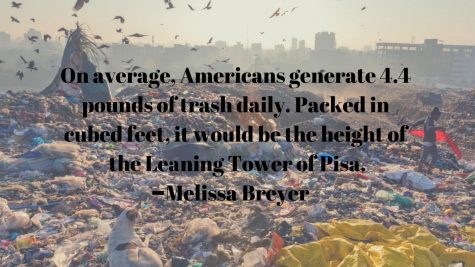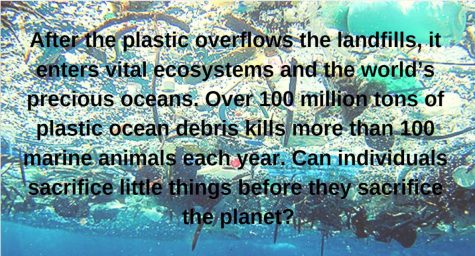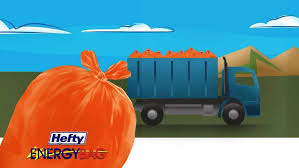Trash talking in Cobb County
December 7, 2018
“It’s just one piece of trash; it doesn’t matter,” 7.6 billion people falsely conceive, as they nonchalantly pile-up their plastic in waste bins. Every year, the United States generates approximately 230 million tons of trash. The seemingly insignificant discarded items accumulate by the masses, until they eventually suffocate society.

Attempting to preserve their precious planet, Cobb County residents utilize monthly recycling services; but the locals’ green-hearted intentions cannot overcome corporations’ money-hungry drive. In the game for profit, recycling businesses repudiate treatable items that other firms can more cost-effectively produce from raw materials. American Disposal, a waste and recycling service in Kennesaw, rejects unprofitable paper, plastic, aluminum, and glass products in their recycling bins. With trashed reuse potential, how can these discarded items ditch the dump?
In June of 2018, Dow Chemical Company and Keep America Beautiful joint-awarded Cobb County $50,000 for The Hefty Energy Bag program. With The Hefty Energy Bag program, waste can divert from landfills and offer communities alternative energy options. Because of its materials recovery facility, number of targeted households, and alternative energy resource markets, Cobb County became one of three communities to acquire the grant for the energy program.
“Keep Cobb Beautiful… is excited about this innovative program and is looking forward to bringing plastic recovery options and technology to Cobb County residents,” Keep Cobb Beautiful’s executive director, Kimberly White said.
The Hefty Energy Bag program encourages households to gather their non-recycled plastics and single-use items, such as: toothpaste tubes, potato chip bags, and juice-boxes, in Hefty energy bags, rather than toss in their trash cans. On weekly waste pick-up days, residents’ place their energy bags amongst their recycling and trash bins for curbside collection.
Aiming to limit landfill accession, but unable to recycle these single use items, where do the scraps go? The energy bags arrive at a cement kiln for thermal treatment, where they undergo incineration, a combustion process for recovering energy. At the kilin, the super-heated waste fuels a fire, used to boil water and create steam. The steam spins a turbine, converting the heat energy into mechanical energy, as a following generator then converts it into electrical energy. From there, the energy flows to transformers for business and household consumption.
Substituting fossil fuels and mitigating landfill surface area, The Hefty Energy program brings economic and environmental benefits its communities. The program’s goals include: improving recycling programs efficiency, decreasing waste management costs, reducing fossil fuel extraction, and alleviating environmental plastic content. The energy program builds on the Great American Cleanup, Dow Packaging, Specialty Plastics, and Keep America Beautiful conservation efforts; but not all the green thumbs signal the go.
Environmental organizations, such as: Greenpeace, the Rainforest Action Network, the San Francisco Department for the Environment, and the Sierra Club Chapter in Omaha, signed a pledge opposing the energy program in their communities. Resentment towards the program derives from their false “recycling” advertising to the public.
“The National Recycling Coalition does not consider the Hefty Energy Bag program a recycling program. The ‘energy recovery’ of the bags is not consistent with the definition of recycling and, therefore, is not a recycling program,” National Recycling Coalition President Robert Gedert said.
The Environmental Protection Agency defines recycling as “the process of collecting and processing materials that would otherwise be thrown away as trash and turning them into new products.” Because the energy bags convert the waste material into alternative energy rather than fresh products, they violate EPA recycling standards.
Another environmental concern regards the energy program’s air pollution. Although still abiding by the Clean Air Act’s protocol, can the Earth handle additional incineration facilities’ carbon dioxide emissions while battling catastrophic global climate change? Besides carbon dioxide pollution, as plastics burn, they emit dioxins, a group of highly potent neurotoxins, detrimental to organisms’ health. Incinerating waste replaces burning fossil fuels, but the alternative energy source fails to rank as a clean one. Which is worse, drowning in plastic or suffocating from emissions?
If a family in Cobb County decides The Hefty Energy Program fits them, they can now subscribe to the program. To help haulers adjust to the community change, the energy program uses a phased approach. Limited to only 20,000 households during phase one, residents seeking energy bags must quickly sign up before the list hits its quota. To qualify for the energy program, consumers must also use American Disposal Waste Management services, the only treatment facility aligned with Hefty’s program.
“[The Hefty Energy Bag program] sounds like something my family would [sign up for]… but it seems like it requires too many hoops to jump through [when you’re just trying]… to do a good thing for our planet” senior Angel Serrano said.
For families interested in the program that miss phase one’s registration, or without American Disposal services, phase two inducts another 20,000 households into the program and offers energy bag drop-off centers coming in 2019. Cobb’s energy bag predecessor communities, Omaha, Nebraska, and Boise, Idaho, show that as the phases evolve, the program’s successfulness increases. After two years of the energy program implementation, Omaha, Nebraska, collected more than 82,174 bags and diverted 47 tons of plastic from landfills. Will Cobb County subsequently succeed?
If Cobb County follows the successful path of the other energy bag communities, non-recyclable plastics and typically tossed trash may morph into alternative energy resources. Although The Hefty Energy Bag Program lowers landfill waste, its emissions bring communities cloudy skies. No perfect solution exists to the anthropogenic ecological footprint, but prompt action must attempt to reverse the human havoc on the environment.


Patricia Furr • Jan 9, 2021 at 3:14 AM
It is the residents that own land before the landfill came that suffers. In Cobb County, they own the landfill property, and have exempt themselves from any permits. Therefore, they can bring any type of waste there. While “KEEPINGCOBBBEAUTIFUL” in other parts of Cobb, our Circle is being ran over by the massive growth in revenue, taking any and all Counties vegetative waste to produce energy and compost. So .we are paying the price. My Mom has asthma with bad days, our homes are covered in black mold and residue, Cobb has never put street lights up, nor have they paved the road. So keep it up!!! You guys look like you care about everyone.